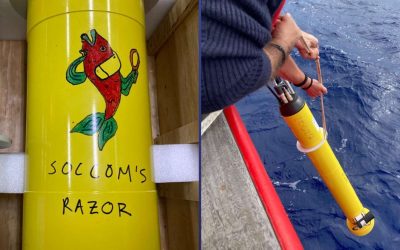GO-SHIP A10.5 (SAGA-345S)
Repeat Hydrography Along 34.5 ˚S
GO-SHIP’s quasi-decadal re-occupation of hydrographic transects spanning the global oceans was implemented and is sustained to quantify changes in the storage and transport of heat, fresh water, carbon, nutrients, and transient tracers (Talley et al., 2016; Sloyan et al., 2019; also Figure 3). These full-depth, coast-to-coast transects measure many of the physical and biogeochemical Essential Ocean Variables of the Global Ocean Observing System and provide the highest accuracy ocean data, attainable only with research ships and specialized, calibrated analytical methods (Figures 4–5).
GO-SHIP is an international component of the Global Ocean Observing System (GOOS). GO-SHIP provides climate-ready, full-depth observations of most of the physical (temperature, salinity, velocity) and biogeochemical (carbon, nutrients, oxygen, trace elements) parameters needed to track changes in climate. The high accuracy of GO-SHIP data make them the underlying backbone of GOOS, as benchmarks for calibration and validation of autonomous observations. GO-SHIP station tracks are repeated every 5 to 10 years, which allows comparison of heat, freshwater, carbon and nutrient distributions over decades.
The GO-SHIP A10.5 location, nominally along 34.5 ˚S, is the latitude where the north-south transport between the Atlantic and the rest of the world ocean is now being monitored.
GO-SHIP A10.5 was previously occupied in 2017 using vessel Maria S Merian, MSM60. There are no other full occupations of this section, although there have been nearby repeated sections along ‘A10’, at 30°S. The A10.5 track was introduced to avoid major topographic features in the west, and provide a clean east-west crossing of the Argentine Basin in the southwest Atlantic. A10.5 crosses the Brazil Current at the coast of South America, and the Agulhas/Benguela at the coast of Africa.
Because this latitude has been selected for monitoring exchange between the Atlantic and the World Ocean, there are current meter arrays that sample these boundary currents: the SAMBA arrays at South America and the SAMOC arrays at the African coast. These are maintained by a multi-national group of South African, US, Argentinian, Brazilian, French and German scientists. Parts of A10.5 are therefore frequently occupied by research ships for servicing the array that often perform CTD stations. Hydrographic measurements made on the array servicing cruises often meet the criteria to be associated GO-SHIP cruises.
Please join along on the journey by following the expedition blog!
Chief scientist: Alonso Hernanez-Guerra

SAGA South Atlantic Expedition Logs
Mesa Yellowfin
San Diego Mesa College - San Diego, CaliforniaMarch 6, 2022Our final deployment was Mesa Yellowfin from San Diego Mesa College. In less than two weeks I’ll be back home in San Diego myself. I’m lucky to see the ocean frequently in my daily life, but without any...
ERA Gryphon
Eagle Ridge Academy - Minnetonka, MinnesotaMarch 2, 2022ERA Gryphon from Eagle Ridge Academy in Minnetonka is in the water! We hit some bad weather this week, and the sheer power of the winds and waves is impressive. As we heave up and down in the swell, I can’t help...
SOCCOM’s Razor
Logos School - Moscow, IdahoFebruary 23, 2022SOCCOM’s Razor (a clever play on Occam’s razor) from Logos School in Moscow, ID has begun its mission! Where will this journey take it? We don’t actually know. SOCCOM floats can’t control their horizontal position. Instead,...
S.H.A.R.K.
Rio del Mar Elementary School - Santa Cruz, CaliforniaFebruary 20, 2022Our next deployment was S.H.A.R.K. from Rio del Mar Elementary in Santa Cruz. The name stands for Showing Animals Respect and Kindness, and was selected because: “Our class loves the ocean and...
Angel Shark
St. Joseph's Academy—St. LouisFebruary 16, 2022Angel Shark from St. Joseph’s Academy in St. Louis is in the water! For our second deployment, there was just as much excitement among the science party to help decorate the float! In fact, a large group tends to gather...
KHS Guppysaur
Kearny High School—San DiegoFebruary 13, 2022Our first float is in the water–KHS Guppysaur from Kearny High School in San Diego! Sitting here writing this from the middle of the ocean, it’s hard to believe that I was back home in San Diego only 2.5 weeks ago. This is...
A10.5 Introduction
Introducing Channing Prend, who will be posting updates for the A10.5 expeditionFebruary 4, 2022After a week-long quarantine in a hotel in Punta Arenas, our cruise is finally underway! Being confined to a single room for a week has affected me twofold. First, it’s...







